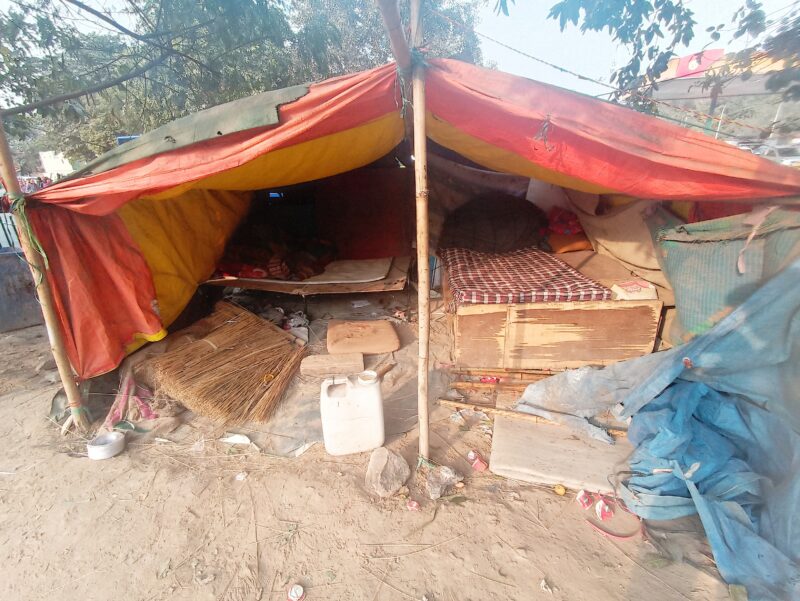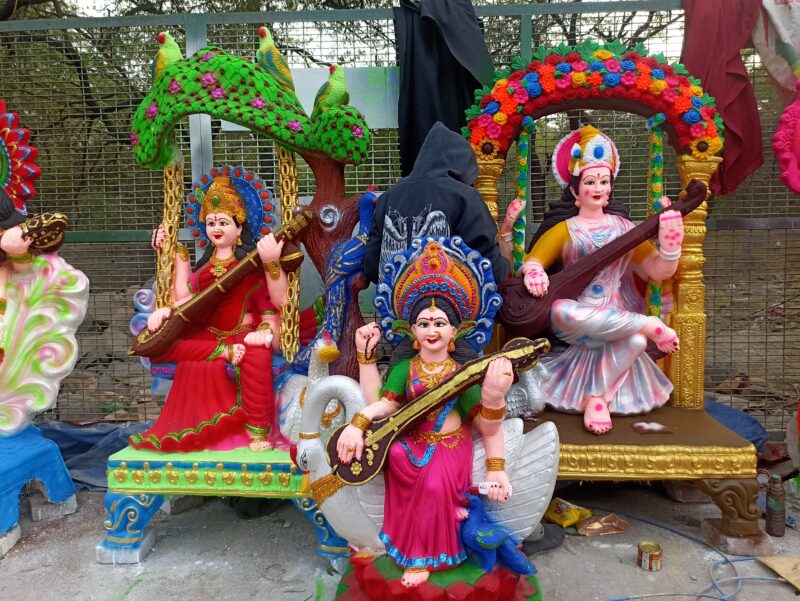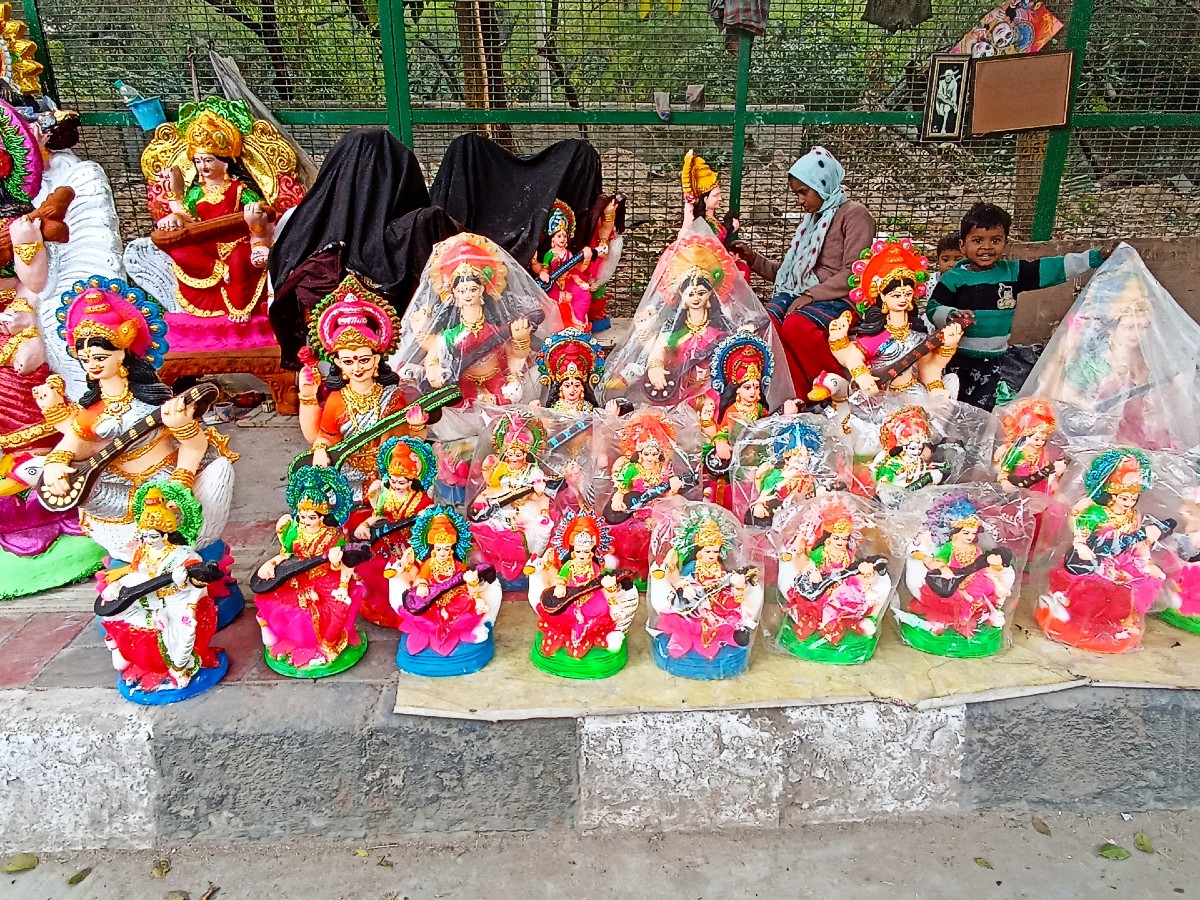Sita’s husband died five years ago and since then she has been single-handedly running a makeshift shop in south Delhi’s Saket, selling deities of gods and goddesses while taking care of her two children and father-in-law.
The 34-year-old had moved to Delhi from Rajasthan 15 years ago after marriage but life in Delhi has been extremely tough.
“In these times, even making ends meet has become incredibly difficult,” Sita told Patriot.
“We earn approximately Rs 1,500 on a great day. Out of that, we invest around a thousand rupees back into the business. I have idols ranging from Rs 300 to Rs 3,000.The majority of our clients purchase little idols for which the profit is Rs 40-50. This is assuming the buyers do not negotiate,” she added.
Sita went on to say that her job requires immense hard work and one has to be very accurate while making an idol which is next to impossible with toddlers around.
“So, I have to mostly leave them with my mother,” she said.
Sita explained that making of idols involves a two-stage process: rubber mold fabrication followed by Plaster of Paris (PoP) molding. The shape of the idol is carved and employed in the preparation of the mold. The PoP slurry is put into the rubber mold which is then shaken to ensure proper distribution of the PoP paste, especially into the fine curves. The excess paste is discarded. The PoP paste is poured into the mold once again to thicken the mixture. And the PoP-filled mold is cured in the sun for roughly 30 minutes to 1 hour.

The idol is then extracted carefully by hand. The prepared idol is then left in direct sunlight to dryfor four to five hours. The various parts of the idol – like hands — are prepared in clay and then joined. Sandpaper is used to smoothen the surface of the idol. It is further blown up with shimmering gold, copper, silver and chromatic hues after a colour coating. The PoP-idol painting requires various procedures that add value.
According to her, “The returns on the efforts we put into this task are not huge, but we’ve spent our entire lives doing this. We don’t even have any other talent to earn, so we’re somehow managing with this alone.”
Sita and her family are living by the roadside.
“We used to live close to this [shop], but the Municipal Corporation of Delhi (MCD) demolished our shelter in order to build a nursery. We’re currently living in a homemade tent by the side of the road, and we’re not sure forhow long we’ll be able to do so. Probably another two months, until we’re forced to leave,” she explained as customers approached her and requested for two little idols.
She told them the price –“Rs 200 for each”.
The customers wanted both of them for Rs 300 but Sita refused, saying that investment in a statue is Rs 150.
“If I offer you two idols for Rs 300, I won’t be able to save anything,” she reasoned. The customers fled.
Sita returned and said that this is what occurs most of the time.
“Sometimes, we are obliged to sell without generating any money in order to survive,” she said.
In Seelampur, Qadir Nadab, a 38-year-old native of Chhattarpur, who also operates a small shop selling idols, said that business was good in the lead-up to the Republic Day as people from neighbouring societies and schools turned up to buy idols.

“Initially, I stationed myself at various spots, like outside a prominent restaurant in order to attract the attention of customers until I was shooed away,” he recalled.
He eventually settled on a permanent location on the bustling main thoroughfare of a residential area. This has been his “job” for three years. He pays no rent for the place where he has constructed a seat for himself and claims that the location has been useful since the people in the nearby residential society celebrate various festivals, which occasionally bring him business.
Nadab also pointed out that this business only works well during festival season and is not a source of regular livelihood.
“We earn a profit of Rs 20–30,000 during Diwali, Durga Puja and Navratri, which is the only time we make a substantial amount. But apart from that, it’s mostly crumbs. That’s why we have to switch to other professions during off-season,” he explained.
The majority of idol makers switch to selling other items like broomsticks and small swimming pool beds for children. Nadab also recalls a time when he was forced to pull a rickshaw in order to earn a living.
“A lot of the time, we are helped by good Samaritans who give us food and blankets in this chilly weather. Many bloggers come with cameras and help us. Some do it for cameras, some do it out of kindness, but the point is, we’re just about surviving and sometimes borrowing from others to survive,” he added.
Kishore Singh, a 42-year-old migrant from Bihar who lives in Noida sector-22, says idol-making was his father’s and grandfather’s profession. But he feels that his kids won’t be pursuing it.
“I am the third generation in this business, and I think I’m going to be the last one since there’s not much this profession has to offer. We already had a limited clientele. Now that too has been taken away by the giants and online markets,” said Singh.
“The job of sculpting idols also demands attention to minute details, which will get difficult as my age increases. The amount of physical effort you constantly put in is just way much for the pennies you get in return,” said Singh.
On being asked about how he managed to make ends meet at a time when everything is so costly, Singh said, “It used to bother us earlier when the rates used to go up every once in a while. However, prices go up every other day nowadays.”
They have gotten used to the rise in prices.
“Also, we belong to a category that has to earn a meal every day,” he added.
He concluded by saying, “the only reason I am persisting with this work is because I am too old to switch to another profession.”
There is another reason why he is continuing it.
“I get the material at a very cheap price. I’ve developed contact with a builder, who I pay on a monthly basis. So, I get the materials very cheap. But even after that, the profit I make is bare minimum.”





